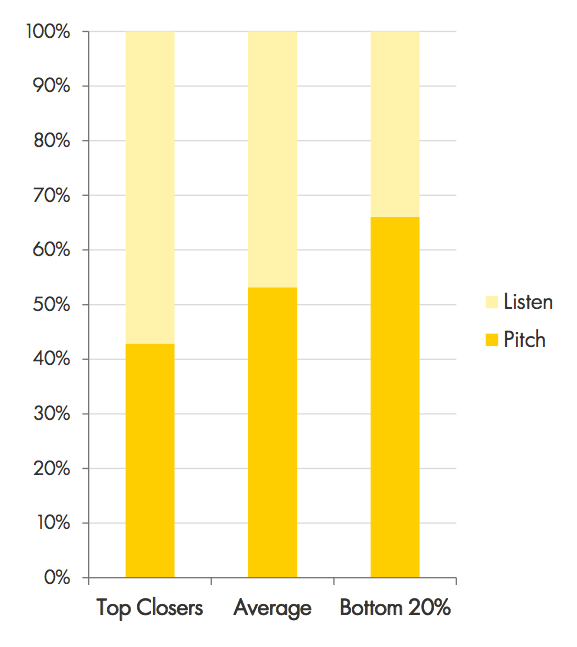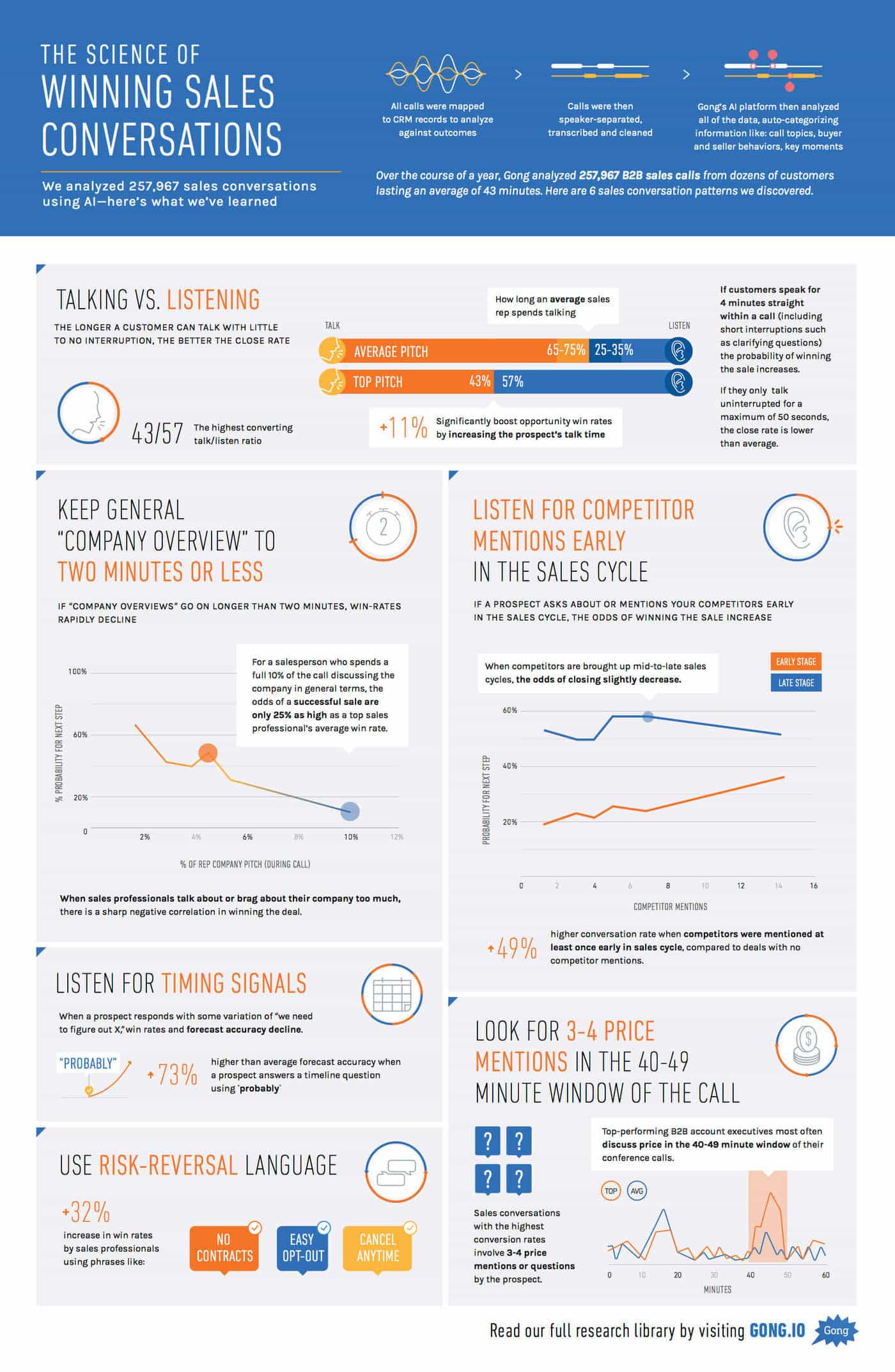Here’s a proven, research-backed tactic that will improve your sales process: Talk less, listen more! If you want to significantly improve the quality of your sales conversations to increase your win rates, the talk vs listening ratio is one of the most important things to consider.
I recently wrote an article on Sales Hacker called “We analyzed 25,537 B2B sales conversations using AI — here are the 5 things we discovered”
If you haven’t read that article, I suggest doing that first.
The first insights we discovered among the analysis were trends related to the “talk-to-listen” ratio.
As it turned out, the “highest yielding” B2B sales conversations hovered around a 43:57 talk-to-listen ratio.

In other words, the data told us that top-producing B2B sales professionals speak 43% of the time (on average), allowing the prospect to speak 57% of the time (on average).
DISCLAIMER: Be sure you know the difference between correlation and causation before taking this data too seriously. Use your judgment.
But again, most sales reps are talking more than they believe they are (65–75% of the call).
How I Improved My Own Talk vs Listening Ratio
When I first started using Gong’s sales conversation analyzer, I was appalled to learn my average talk-to-listen ratio was 72:28!
Since I started tracking and measuring my own talk-to-listen ratio, it has improved. (I’m trending around 52:48 these days — can you say “Talkers Anonymous”?)
But how do you accomplish that without “interrogating” customers, peppering them with an endless stream of pointed questions until they grow irritable?
When most sales professionals hear the data about the 43:57 talk-to-listen ratio, they usually revert to asking so many questions that it can feel interrogative and annoying.
So here are four unconventional methods to get your potential customer talking more (about the stuff you want them talking about) without peppering them endlessly with generic question after question.
4 Unconventional Ways To Talk Less, Listen More

#1: Say, “It Seems Like You ________________________”
In his book Never Split the Difference, Chris Voss calls this technique “emotional labeling” — and it is empathy on steroids.
After you’ve asked your prospect an effective, targeted question, verbally “call out” an emotion you observed the prospect express while they were answering.
You can simply finish one of the following sentences:
- “It seems like you ________________”
- “It looks like you _________________”
- “It sounds like you ________________”
For example, if asked a well thought-out “problem” question and the prospect responds, expressing a hint of frustration with the problem, you can try saying the following:
- “It seems like you’re personally frustrated by this challenge your company is going through.”
If the emotion you “labeled” was accurate, your prospect will feel such a deep level of feeling understood, they will be compelled to release a new floodgate of emotional information.
The two tricks to making this work:
- You have to be accurate with your emotional label (i.e. listen carefully)
- You must pause after the label and let your prospect fill the void (count to four in your head).
If you speak too soon, you’ve negated this technique’s positive effects.
#2: The Socially Awkward Pause
When I first learned that my talk-to-listen ratio was averaging 72:28, Gong’s CEO Amit Bendov gave me a little tip:
“Chris, you are so eager to respond after the other person is done speaking that you begin speaking as soon as they’re done. Try letting an awkward three seconds go by between the time they’re done speaking, and the time you respond.”
I have to admit, this felt weird the first few times I tried it.
But Amit’s advice didn’t disappoint.
I’m still surprised at how often prospects “add on” to the end of their responses when I just shut up a few seconds more than what feels natural.
And often, that extra information they share with me is pure gold.
Bottom Line: It takes discipline to talk less, listen more. But with a little focus, you’ll be amazed with the results.
#3: Describe Their Problem Better Than They Can Themselves
When you can describe your prospect’s problem more accurately than they can, they will automatically trust you and assume you know the best way to solve it.
Many times prospects will have a lingering problem that they “can’t put their finger on.”
When you can put words to the problem they’ve been unable to, the light bulb in their head will light up. They’ll experience a true epiphany.
Here’s an example of how I’ve applied this in a sales call at Gong:
“Most of the sales managers I speak with, deep down, are afraid of having too many bad months in a row. They do deal reviews with their reps to try to stay on top of things, but they don’t truly know what’s going on in deals since they are blind to what’s happening at the sales call-level. To what extent does this resonate with you?”
If you’ve been able to describe their problem accurately and in emotional terms, they will practically become entranced on the other side of the phone.
Most people do not make the effort to understand another person deeply.
Be the one who does, and you’ll be the “one-eyed man in the land of the blind.”
The caveat to this is you have to do the work to understand your buyers on a very deep level.
There is no shortcut.
#4: Ask Questions That Imply You Know the Answer to Their Problem
This is similar to the technique above.
When you ask a question that “nails their problem on the head,” they will emotionally lean forward and open up.
Here are a few examples we use here at Gong:
- How often do your account executives forget to hit the “record” button on GoToMeeting?
- Are you struggling to “capture” amazing sales call recordings to use as training content later on?
- How familiar are you with what’s happening on the front lines of your sales organization?
Notice these questions are highly calibrated toward the problem we solve.
They aren’t your generic sales qualification questions that so often lead to a monotonous “interrogation.”
What Else?
There are dozens of interesting, tactful ways to not only get customers talking more, but direct the conversation to a mutually beneficial end.
For more advice on how to “stop talking,” watch this 2-minute video:
How do you talk less, listen more?
What are some of your tips, tactics, strategies, and insights for getting your prospects to open up in the right way?
I’d love to hear them.
PS – Check out our infographic on the science of winning sales conversations!




